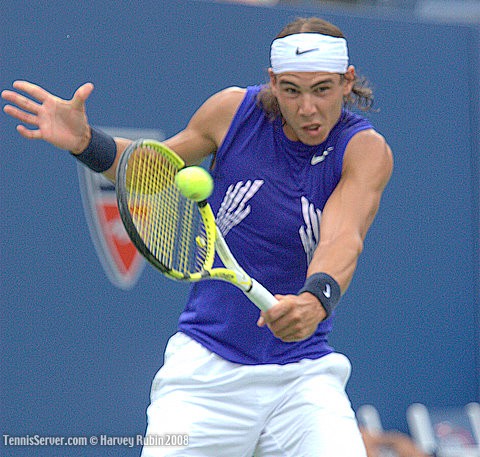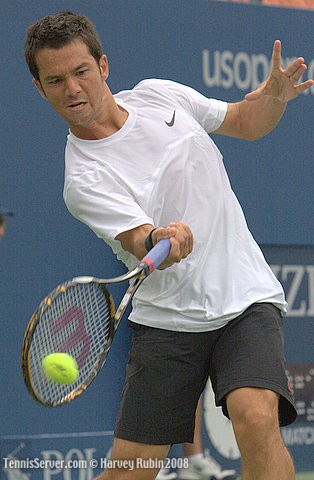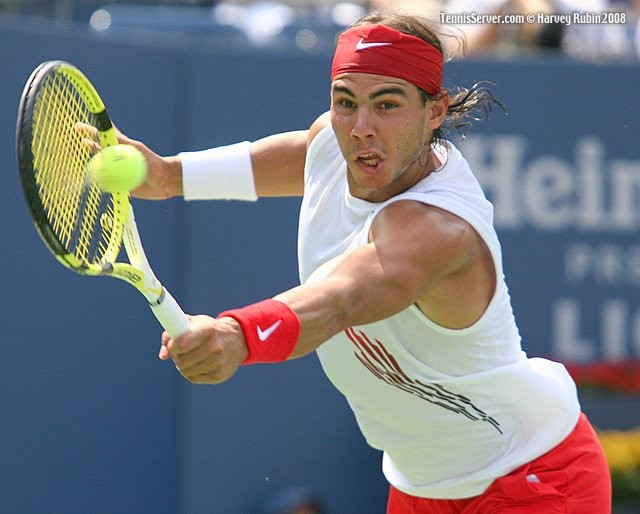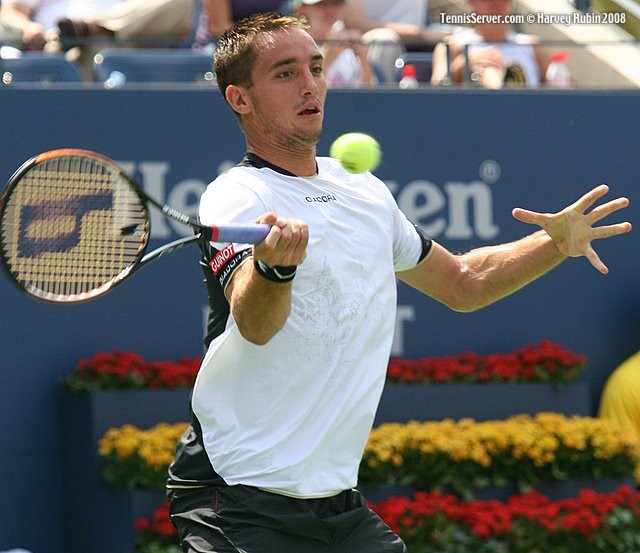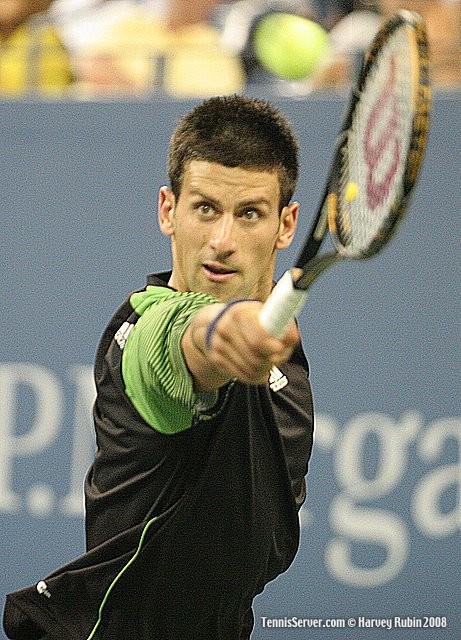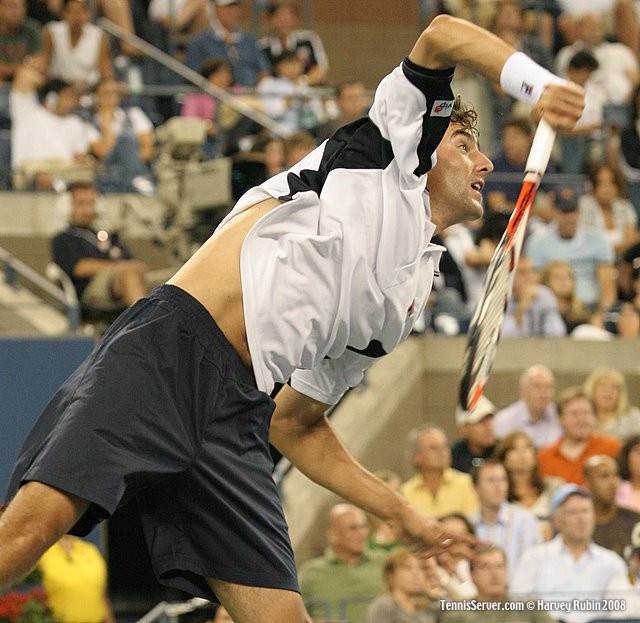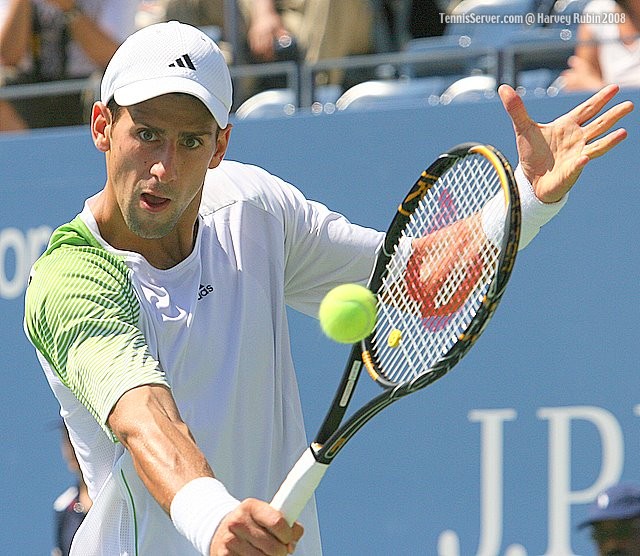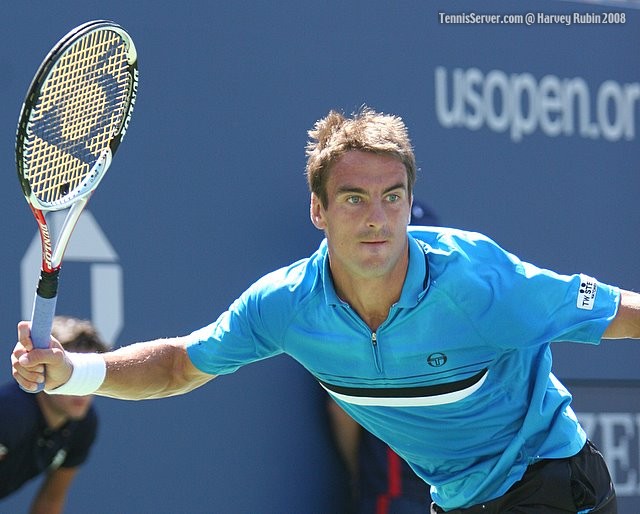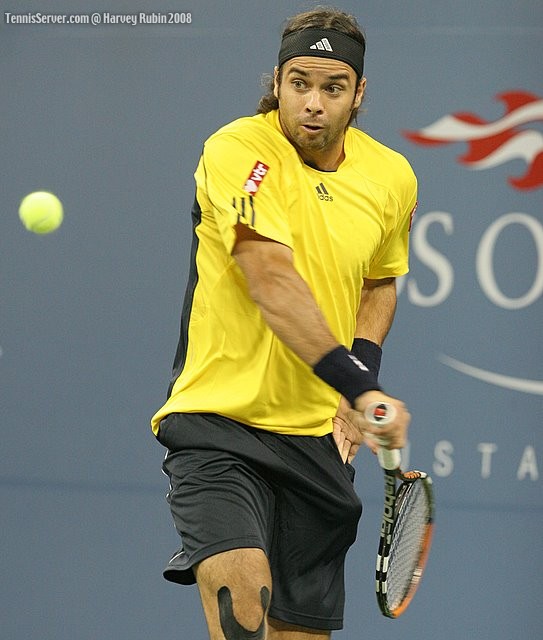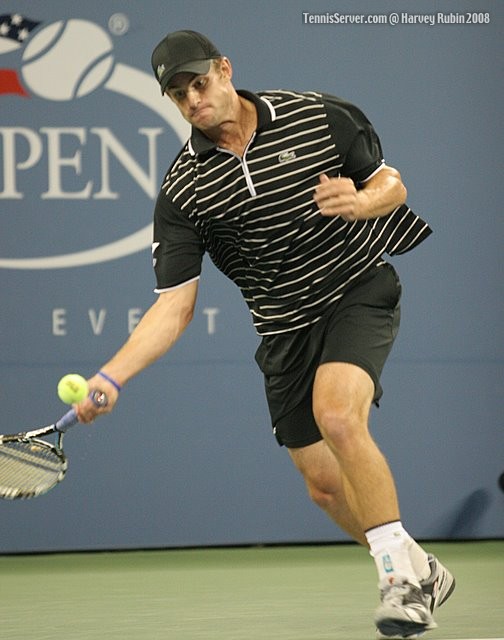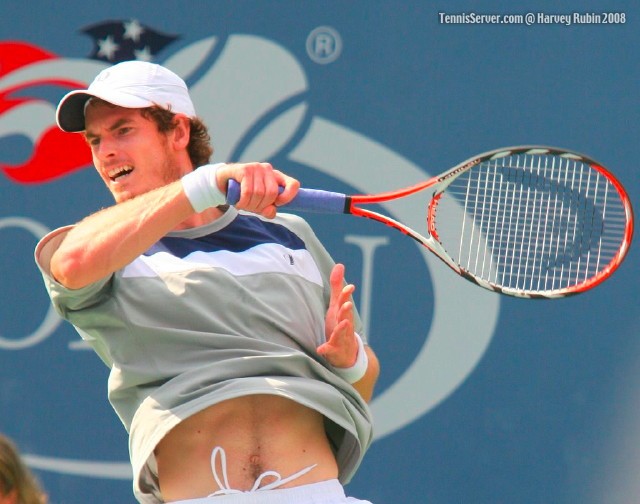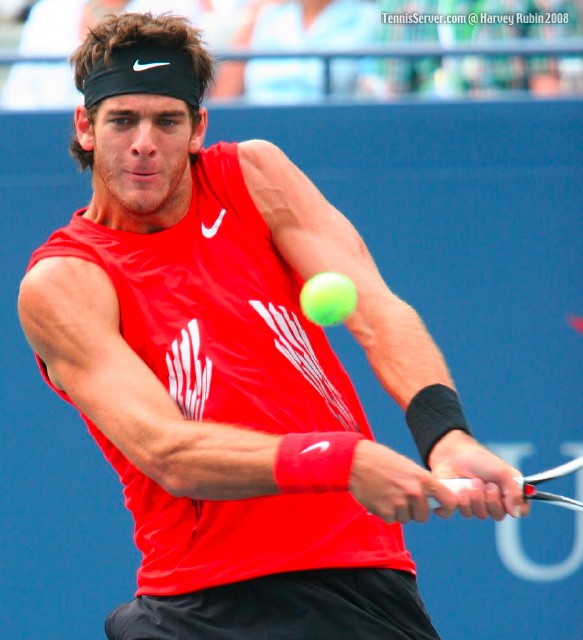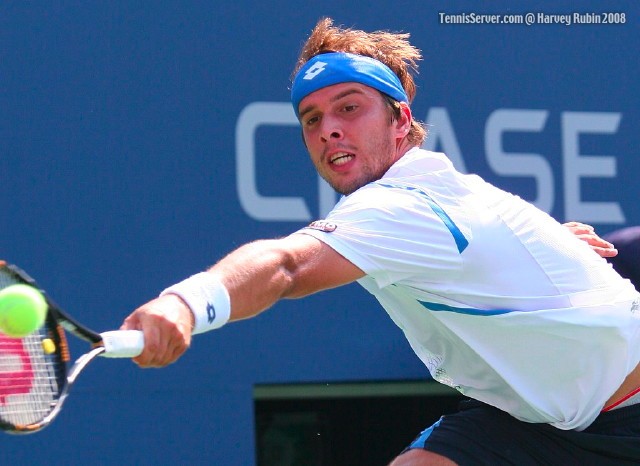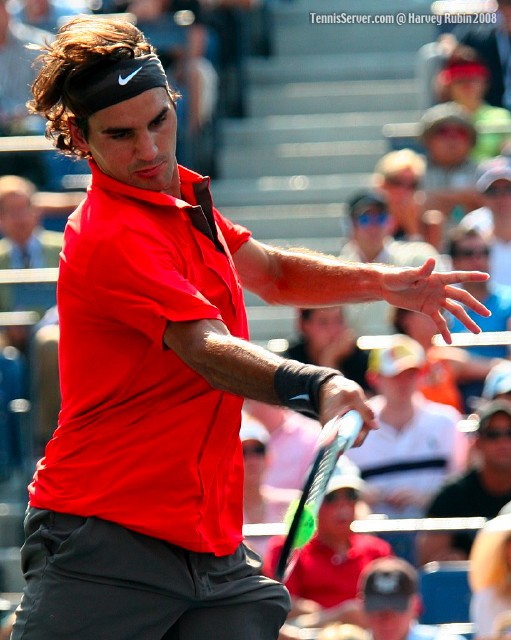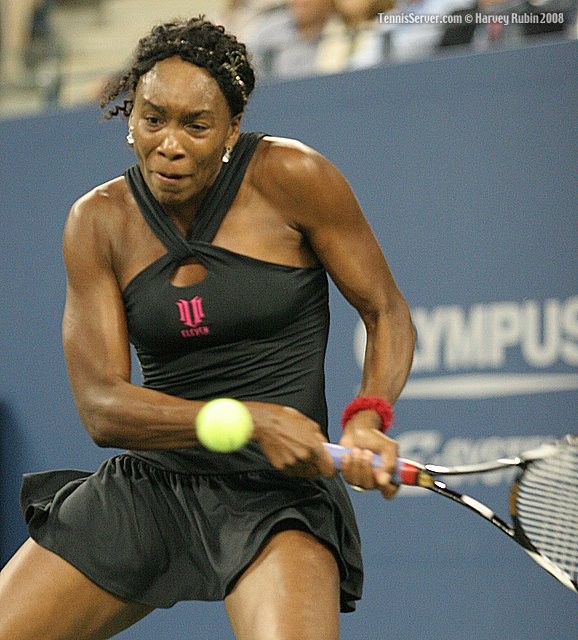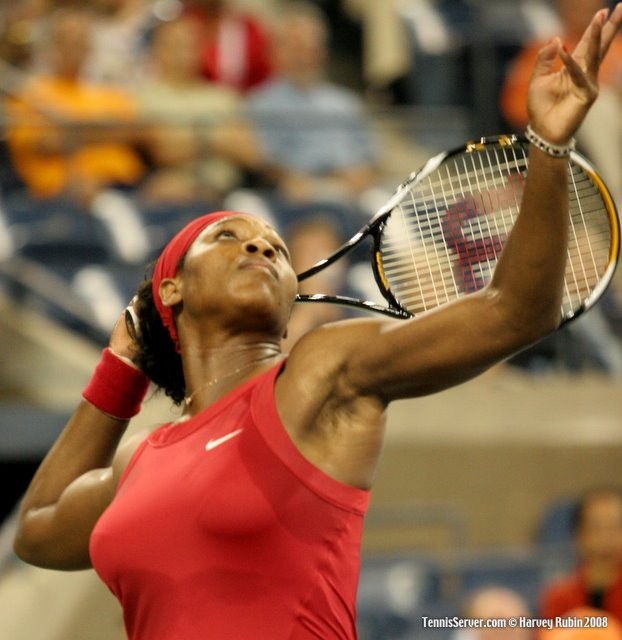September 8, 2008 Article Latest Between The Lines Article Between The Lines Archives:
Tennis Server
|

 |
by Ray Bowers
The human drama of the Open surely embraces those aspirants who are not in the top tiers, male and female. The stories of these many others, whose bid for glory is the current culmination of months, indeed years, of sacrifice and effort, can be just as compelling as those of the prime contenders. For coherence, however, our narrative is here focused on the superstars. Providentially, however, our comments on the unfolding fates of our favorites are also crossed with the brilliance of several less-well-known risers, many of them young, all likely to be heard from in the future. Rain-free skies and mild temperatures prevailed over most of the two weeks in New York, though on some dates players spoke of shifty wind conditions or high humidity. The approach and passage of hurricane Hanna altered matters in the final weekend, but the revised schedule provided a reasonable scheme for players and fans alike. Throughout the tournament, the courts were said to be fast-bouncing, a matter confirmed by the unusually high number of sets ending in tiebreakers. (The frequency of tiebreakers correlates well with serving effectiveness and court speed.) There were more tiebreakers than at any U.S. Open since I began tracking the data nine years ago. As usual, the most recent Australian and French Opens produced fewer tiebreaker sets, Wimbledon more. As would be expected, the fast bounce gave the advantage to the attacker, and there seemed a higher-than-usual percentage of points decided at net. Lower-ranked players often forced the headliners to produce their best tennis, although there were relatively few surprises in outcomes. The last four players standing in both men's and women's singles at the Open were the exact ones predicted in our pre-tournament analyses, which had been based on weighted past results in the men's case and on recent head-to-head outcomes in the women's. The golden quality of the predictions would not last into the last two rounds, however. EARLY ROUNDS: THE MEN'S BIG SIX Emerging from our pre-tournament calculations was a top tier of three prime superstars--Nadal, Djokovic, and Federer, rated in that order in their chances of winning the Open. Next came a second tier consisting of Davydenko, Blake, and Murray. All but one survived the first three rounds of play. Our foremost favorite, Rafael Nadal, in first-round action found himself tested by German pro Bjorn Phau, who showed excellent court movement and a sizzling backhand one-hander. Rafa won in three straight sets, but two of them were settled in tiebreakers and the other by a single service break. At no time was Phau badly outplayed amid countless thrilling points and games. Probably the difference was Rafa's relentless overspin and its usual effect on an opponent's physical and mental reserves. The day gave little evidence of Rafa's expected superiority over all others.
The non-survivor of our elite group was James Blake, who had trouble in the first round, outplayed in long stretches by left-handed teen-aged Donald Young. Overall, Young equaled Blake in his excellent movement and striking power, and showed better ability at net. Matters reached four-games-all, fifth set, the rallies every bit as fierce as those seen earlier, before a strong finish by Blake closed out the evening. Young lost, but the affair seemed a foreshadowing of what must be a superb career ahead for Donald. In his next appearance, James's third-round opponent was unseeded Mardy Fish, who had been the losing finalist to Cilic the previous week in New Haven. In overcoming seeded Mathieu in the Open, Fish delivered 27 aces and zero double-faults. Now, Mardy repeated his strong serving, delivering sixteen aces in overcoming Blake in straight sets. As the first week ended, three rounds of men's singles had been played, two rounds of doubles, and one round of mixed. These matches constituted more than three-fourths of the full tournament. In the tally of matches won by nation to date, the eventual pattern was now evident.
U.S.A., 23 match wins With the Bryan twins likely to add as many as four more wins in doubles, and with both Roddick and Fish still alive in singles, first place in the final tally by the American males seemed assured. If so, it would end Spain's run of success in Slams, the Nadal-led Armada having come out ahead at both Garros and Wimbledon 08. Meanwhile Spain's current second-place advantage over France seemed likely to increase, given the likelihood of further contributions by Rafa in singles and Lopez-Verdasco in doubles. MEN'S MIDDLE ROUNDS A second member of our Six, Nicolay Davydenko, was eliminated by European player Gilles Muller. Also severely tested on Second Monday and Tuesday were several others of our elites. Rafael Nadal attained the final eight in a bruising four-setter with American Sam Querrey, age 20 at height 6-6. Querrey's severe serving and potent forehand kept matters much closer than expected. Rafa was generally content to force play only moderately, though his relentless high-bouncing ground strokes seemed less effective against this tall (6-6) Californian than against most other opponents. Novak Djokovic narrowly escaped his fourth-rounder against Tommy Robredo. In losing the fourth set Novak labored under various infirmities, including hip and ankle injuries and upset stomach. Most serious was Novak's obvious tiredness after long rallies that seemed related to breathing difficulties of a kind seen on several past occasions. With Robredo playing well, it seemed that Tommy would surely win the concluding fifth set. But instead it was Djokovic who somehow found his earlier power and accuracy, while Tommy let critical points slip away.
I could not remember ever watching Andy Roddick perform at a higher overall level than in defeating Fernando Gonzalez in straight sets Tuesday evening. Andy's serve and power stroking were there as usual, but his movement, his consistency in avoiding error, and especially his effectiveness at net seemed at heights rarely shown by Andy, certainly in recent months. Andy's chances seemed excellent against his badly worn, next opponent, Djokovic, two days ahead.
Juan Martin del Potro, recent champion at the Legg Mason in Washington, again showed his magnificent stroking power. Andy Murray answered well, in stretches mixing excellent defensive play with frequent counter-attacking. Murray played well in winning the tiebreakers ending the first and second sets, but with a service break in hand and his opponent seemingly tired, Murray let slip the third set and fell behind in the fourth. But with del Potro now apparently hurting and badly fatigued, it was Murray who narrowly won the fourth and final set, ending a magnificent spring and summer for the teenager from Argentina.
Qualifier Gilles Muller played well against Roger Federer, showing an excellent lefty serve and good ability to place shots consistently close to the sidelines and corners. Roger seemed content to let the play come to him, turning on just enough heat to stay out of danger. Roger won all three sets closely.
The semi-finals were now set. None of the principals had shown superior form compared with the others in the tournament to date. All had lost at least two sets enroute. WOMEN'S BIG SIX Our pre-tournament ratings of the top women rested on this year's head-to-head results. Of our highest-rated six, all but one advanced safely through four rounds. Three of them did so impressively, without losing a set, namely Elena Dementieva, whose serves were now reliable and forceful, and both sisters Williams. The only departee of the Six was Ana Ivanovic, whose injured hand had forced her near-inactivity since Wimbledon. A lack of full recovery probably explained her poor showing here, narrowly surviving a first-round and then losing a second-round three-setter against an unseeded player. Meanwhile two of our primes--Safina and Jankovic--both encountered mild trouble, both dropping a set in early matches. Dinara Safina struggled against teen-aged Swiss player Timea Bacsinszky. Dinara's first serve would not find the box, her second was badly punished by her 5-7 opponent. An injury or sickness hindered Timea thereafter, but another stretch of overhitting again afflicted Safina, nearly costing her the second set. Dinara finally took control of her own hitting and, with that, she closed out the third set. Also in early trouble was Jelena Jankovic. With the score at five games all in the third set, Jankovic seemed more tired than her Swedish opponent, Sofia Arvidsson, but Jelena fought through to claim the final two games. After the match Jelena was troubled by leg cramping, and she later lost a set before defeating the firm-stroking teenager Caroline Wozniacki, from Denmark. In the quarter-finals, three members of our top group--Jankovic, Dementieva, and Safina--all moved through their assignments, all scoring straight-set wins over lesser-seeded foes. Of the three, Safina faced the highest-seeded opponent, but Dinara's relentless serving and stroking heavy artillery kept most points short against the dangerous Flavia Pennetta. The last quarter-final, Serena against Venus, was also the tournament's first head-to-head meeting among our Big Six. The first set seemed rough, scarred by a rather high number of error-shortened points, the onlooking crowd relatively passive, uncertain which player to encourage. The second set, however, brought long stretches where both sisters seemed at close to their highest level, the crowd becoming increasingly aroused. It was athletic, power tennis, of a dimension that probably no other two women could have sustained. Venus was the more aggressive player, in power, placement, and positioning, striking more winners than Serena but also the greater plurality of errors over winners. (Venus's unforced errors outnumbered Serena's, 45 to 28.) Both sets ended in tiebreakers, both won by Serena, who in both sets came from behind to reach tiebreak game and then from behind to win the tiebreaker. There were a total of ten set points favoring Venus, but every one was won by Serena. Probably Venus should have won the match, but random chance, Serena's raised play, and perhaps an element of intimidation afflicting Venus all contributed to the outcome. Summoning her highest level of determination amid fierce displays of emotion, it was Serena who attained the heights over her more composed sister.
Russia, 27.5 match wins Both the Russians and the Americans had good prospects for breaking the tie. Two Russian women remained alive in singles (Dementieva and Safina). One American was still in the singles (Serena), two in the doubles (Raymond and Huber, each with a partner from another country), and one in the mixed (Huber). WOMEN'S FINAL FOUR Gusty wind troubled the Friday afternoon semi-final pitting Elena Dementieva, who was the recent Olympic champion and my choice to reach the Open final, against Jelena Jankovic. Both players stayed mainly at baseline, both pressing opponent only moderately in effort to avoid errors. After a shaky start, Jankovic became the more reliable striker, hitting more confidently, her slightly better-controlled movement about the court allowing better adjustment to the changing wind. The unforced errors gradually built up against Dementieva, and after a while her hated double-faults reappeared, further bedeviling the tall Muscovite. Elena tried to step up her hitting velocity and aggressiveness in the second set with some success, but once again an early service-break advantage went away. The final game, Elena serving, went dismally for Elena. Jankovic d. Dementieva, 64 64. The winds if anything worsened in the second semi, where again the player better in control of her movement and with the more compact style of delivery became the winner. Serena Williams stayed composed and managed to adjust very well to the difficult conditions, lowering her serving toss and adjusting her hitting position energetically to react to the ball's unpredictable path. Meanwhile Dinara Safina's generally heavier hitting led to many errors, and her frustrations at the wind and herself, freely expressed, only worsened matters. Consistently throughout the match, Dinara's unforced errors were twice as frequent as her winners. I believe that Serena would have won even in perfect conditions, but the wind and Dinara's emotional volatility made it easier. S. Williams d. Safina, 63 62. In the Sunday evening final, delayed one date by Hanna, Serena followed the pattern of play she had shown throughout the tournament, finding an excellent balance of attacking and safety. Aside from her outstanding overhead game, only occasionally did she try to end points with a single strike, instead keeping her extreme power in reserve and dominating points using a well-controlled 90-percent level of pace. Thus--except in Serena's serving--the ball usually travelled not much faster off Serena's racket than off that of her opponent--Jelena Jankovic. Jelena fought well, taking the initiative often but lacking quite enough firepower to break down Serena's excellent movement to the corners and potent replying. Early on, it seemed clear that Serena's advantages in serving, at net, and in stroking power would prevail if Serena could hold down her errors, as indeed happened. Jelena was not badly beaten--she needed only to hold her serve one more game to win the second set. But matters unraveled at that stage, including one or two double-faults. S. Williams d. Jankovic, 64 75. It was Serena's third Open crown, her first since 2002, a glorious reaffirmation of the greatness of this unpredictable but always fascinating athlete. MEN'S FINAL FOUR Roger Federer's semi-final win over Djokovic in four sets followed the pattern seen in many past Federer triumphs. Roger preferred winning points by his own (1) strong serving, which included 20 aces (vs. six by Djokovic), (2) patient rallying, confident in his own superiority in avoiding errors, and (3) extending points by expert defense when his opponent had the immediate edge. Meanwhile the four-time champion remained always a threat to force matters by aggressive play, and indeed there were some wonderful backhand down-the-line immediate winners. But his approach was generally patient, a mode probably favored by the coolish, humid, and somewhat windy conditions as hurricane Hanna neared. With Roger at his best and using his formula skillfully, Djokovic's main hope lay in attacking. Certainly, Nole executed many superb forcing ploys, including some magnificent strikes from behind baseline and also a high statistical percentage of points won when at net. But all too frequently when Djokovic earned a striking opportunity from inside baseline Nole's strong approach shot bid would misfire, whether catching the tape or landing just outside the lines. I was left with the impression that the most significant difference lay between (1) Federer's ability seen over the years to attack with shots of both extreme power and very heavy topspin and (2) Djokovic's unreliable attacking-shot work on this date. Federer d. Djokovic, 63 57 75 62. Troicki, Querrey, and Fish--one after another Rafael Nadal's earlier opponents in this tournament had shown how strong, aggressive play could make serious trouble for Rafael Nadal. Now Murray, almost shockingly, for one set swept aside Rafa's defenses by attacking with highest skill. Seldom missing, Andy unleashed rockets, one after another, toward narrow openings, often surprising Nadal with his power, precision, and deceptive way of stroking. Again and again, a sluggish Rafa found himself pressed to the sides, corners, and deep. Andy's forehands and backhands carried only moderate topspin, but they commanded plenty of velocity--enough to score frequent winners just out of Rafa's effective reach. It looked as if Rafa's long year--surely one of the finest in tennis history--including his triumph at the Olympics, may have produced in Rafa an accumulated tiredness that was now sapping the energy in his play. Matters became closer in the second set as Andy's errors increased and as Rafa tried to step up his play. But the set-ending tiebreaker went to the Scot player--by the margin of a single mini-break soon after a Rafa strike had almost, but not quite, dribbled over the net upon meeting the tape full-on. Then starting set three, Rafa answered his loss of two sets with renewed energy, scoring an early service-break, just before the rains of Hanna arrived. The stoppage of play probably hurt Nadal's chances, as Murray had seemed the less fresh player. Upon resumption the next day, Rafa successfully closed out the third set and started well in the fourth. Both men were playing intelligently, keeping pressure on opponent but seldom taking high risk of error. But unmistakably, it was Murray who was--by narrow margin--slightly the firmer and more aggressive stroker, the abler at covering court and handling opponent's thrusts, the better at avoiding error. In his first Slam semi, Murray won in four sets, setting up a next-day engagement with Federer. Murray d. Nadal, 62 76 46 64. The championship match on Monday afternoon brought plenty of thunder, but most of it was Federer's. During the first set, Roger's forehand was as magnificently potent as ever before, the ball reacting to Roger's extreme racket velocity and overspin by seeming to dive downward to intercept the lines. Andy Murray too hit many fine shots, but the penetration of the Federer forehand was decisive again and again. Roger won the first two games of the second set similarly, but as errors now began to creep into Roger's arsenal, Murray regained the lost break, and the games thereafter stayed even. But in the twelfth game, Andy serving, Roger stepped up his net-attacking, delivering four consecutive winners, two of them at net and one of them another forehand sizzler, to claim for himself a two-set lead. Roger's net-attacking continued into the third set, while a discouraged Andy could do little to stem the tide. Roger took the first five games of the set, and a few minutes later closed out the affair. Federer d. Murray, 62 75 62. It was Roger's fifth consecutive U.S. crown and his only Slam triumph of the year. Although the year-end crown remains apparently out of reach for Roger, his newest triumph makes the important assertion that there is yet more splendor ahead in his regal career. THE NATIONS The victory of the Bryan brothers in the men's doubles scored six match wins, comfortably cementing the U.S.A. males atop the contingents from all other nations in the final tally of match wins.
U.S.A., 30.0 match wins Among the women, the final weekend successes of Serena Williams in winning the singles and Liezel Huber as a member of the winning women's doubles pair lifted the U.S. array over the Russians. The Russian tally remained unchanged when both Safina and Dementieva lost their semi-final singles. It was the first time since Wimbledon 04 that the Russkayas failed to score highest in a Slam.
U.S.A., 31.0 Important Fed Cup and Davis Cup play among the nations lie just ahead, including the Fed Cup final round one week after the Open and the Davis Cup semis one week thereafter. Stay tuned.
--Ray Bowers
1995 - May 1998 | August 1998 - 2003 | 2004 - 2015
This column is copyrighted by Ray Bowers, all rights reserved.
Following interesting military and civilian careers, Ray became a regular
competitor in the senior divisions, reaching official rank of #1 in the 75
singles in the Mid-Atlantic Section for 2002. He was boys' tennis coach for four
years at Thomas Jefferson High School for Science and Technology, Virginia, where
the team three times reached the state Final Four. He was named Washington
Post All-Metropolitan Coach of the Year in 2003. He is now researching a history
of the early pro tennis wars, working mainly at U.S. Library of Congress. A
tentative chapter, which appeared on Tennis Server, won a second-place award
from U.S. Tennis Writers Association.
Questions and comments about these columns can be directed to Ray by using this form.
|



October 2022 Tennis Anyone: Patterns in Doubles by John Mills. September 2022 Tennis Anyone: Short Court by John Mills. |
 You will join 13,000 other subscribers in receiving news of updates to the Tennis Server along with monthly tennis tips from tennis pro Tom Veneziano.
You will join 13,000 other subscribers in receiving news of updates to the Tennis Server along with monthly tennis tips from tennis pro Tom Veneziano. 
